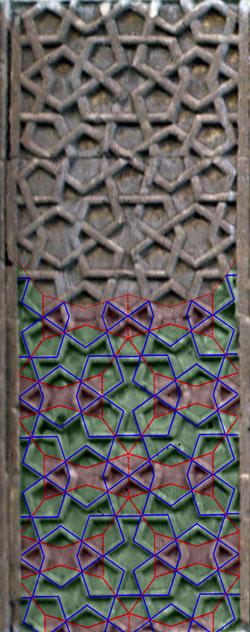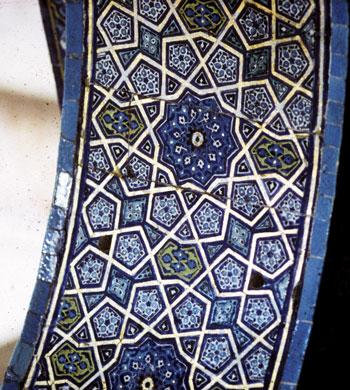 I have written before, here, how the study of sacred geometry and harmony and proportion can point the way to scientists, when describing the discovery of quarks in the early 1960s. Here is another example and the end of the story is this year's Nobel Prize for Chemistry.
Anyone who has studied geometry will know that only threefold and fourfold symettrical patterns are preferred when covering large areas because patterns based on this symmetry will fit together exactly without creating gaps. The Islamic craftsmen of, for example, 13th century Turkey, overcame this difficulty by developing a system of longer range order and using irregular shapes filling the gaps, but creating the sense of a regular order. This way they could create geometric patterns based upon, for example, fivefold symmetry.
I have written before, here, how the study of sacred geometry and harmony and proportion can point the way to scientists, when describing the discovery of quarks in the early 1960s. Here is another example and the end of the story is this year's Nobel Prize for Chemistry.
Anyone who has studied geometry will know that only threefold and fourfold symettrical patterns are preferred when covering large areas because patterns based on this symmetry will fit together exactly without creating gaps. The Islamic craftsmen of, for example, 13th century Turkey, overcame this difficulty by developing a system of longer range order and using irregular shapes filling the gaps, but creating the sense of a regular order. This way they could create geometric patterns based upon, for example, fivefold symmetry.
Move forward to the 1970s and Cambridge mathematician Roger Penfold developed the same idea (independently and unaware of his Islamic predecessors). He called his irregularly shaped insertions 'darts'. About 20 years later the similarity of Penfold's darts to the Islamic tiled patterns was noticed.
These abstract patterns could be extended into three dimensional structures and in the early 1990s microstructure of materials were observed by an Isreali chemist that included, in essence, three-dimensional darts. Here were real materials whose microstructures had been anticipated by the Islamic artists of the 13th century. The discovery of Daniel Schechtman went against the established ideas of what a crystal was his work was not accepted initially. The lab that he was working for asked him to leave. Finally, his work has been recognised now, 20 years later, as ground breaking and he has been awarded the Nobel prize.
The study of traditional proportion and harmony is the study of the natural patterns and rhythms of the cosmos. For the ancients the starting point was those aspects for which there was a consensus of beauty, for example, in enumerating musical harmony. What is so interesting to me is that the patterns seen in a macro scale are observed in atomic and even sub-atomic scale by scientist.
It reinforces the point I made in my first article. That a traditional education in beauty will enhance the creative process. Even in scientific research, ideas are not generated by reason. The process of scientific discovery comes through the observation of nature and then 'seeing' solutions to problems. These solutions just occur as ideas or hunches. The scientist sees the symmetry and order in the situation and can intuit what is missing or what completes the picture, so to speak. Reason is used to test these hypotheses and to confirm or reject them. Of course, this also means that any discipline in which creativity is an asset would benefit from such and education...which is just about every situation in life.
There is another interesting aspect to this tale. It emphasises how the scientist, the mathematician and the artist are all seeking to represent the natural order in different ways, but in their different approaches arriving at the same solution. The scientist is describing mathematically the order that he observes in nature; the mathematician seeks to portray perfect pattern and order in the abstract world of mathematics that conforms to logic and reason; and the geometer seeks to reveal the beauty of the idealised natural order. They are all approaching the same underlying truth and revealing it in different ways.


